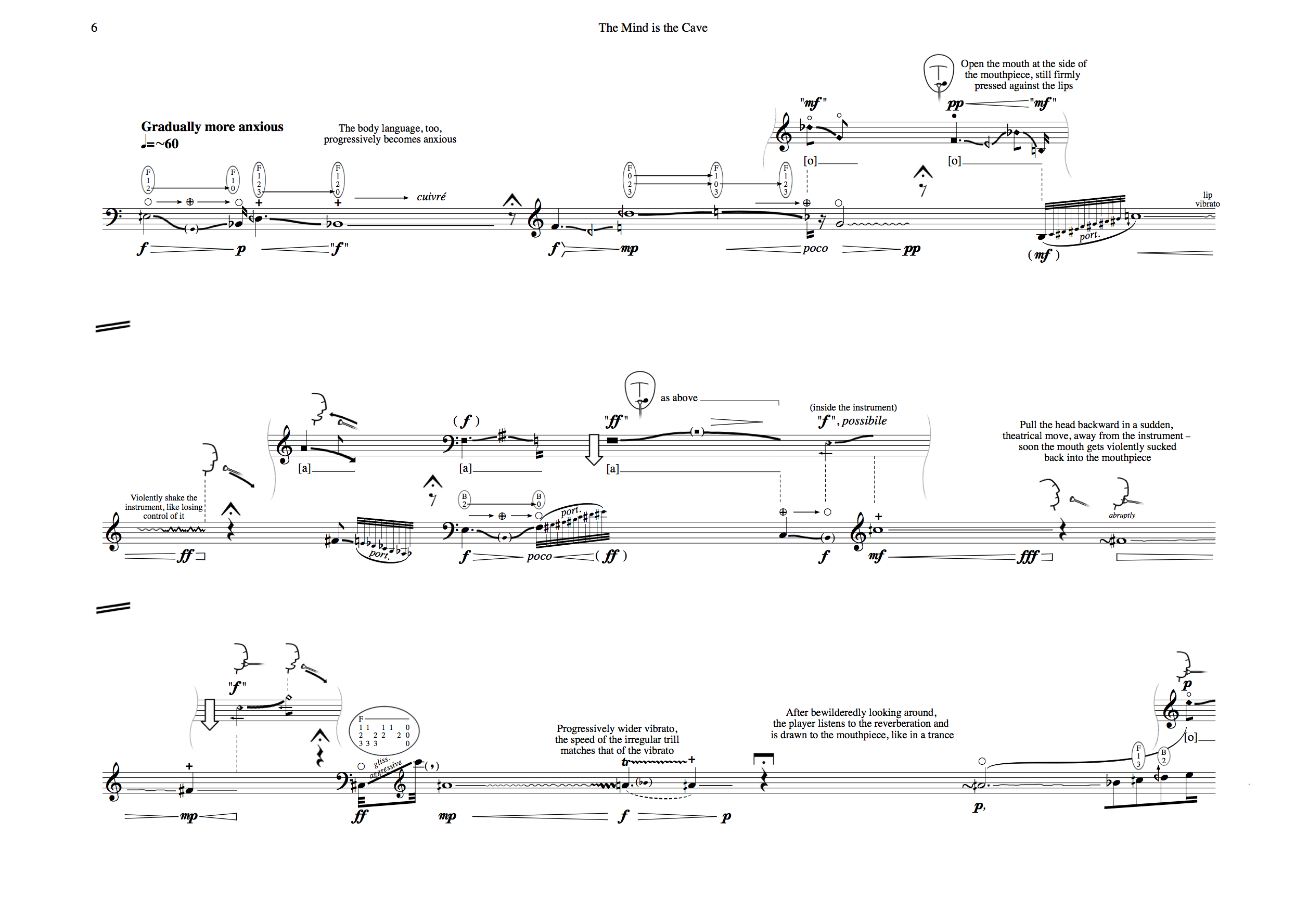A piece for acting (and singing) horn player, written in 2017 and premiered in Frankfurt on April 27, 2017 by Clemens Gottschling.
The Man is still imprisoned in the allegorical Cave described by Plato. The Cave is resonant and a magic horn resting in the middle of the scene acts like a device that, similarly to the fire in the allegory, projects a false sound- image on the walls. This is interpreted by the Man’s mind as a supernatural response. During the piece, the Man tries to communicate with the resonant phantom reply. He is deceived by the seemingly lively nature of the response and falls gradually into the illusion of being possessed. The louder the echo grows, the more frightened his screams become, originating a vicious circle of anxiety. Ultimately, the interlocutor is simply the natural echo produced by the structure of the Cave, but the Man cannot realise his mistake. Once he is left screaming alone without any horn sound reverberating, the piece finishes with the sole echo of his last cry, abruptly breaking the illusion of the mysterious conversation.
The performer represents a human being in the act of communicating with an alleged presence. The piece is set in a place with a largely resonant acoustics.
The projection property of the instrument fills the space with the longer echo, besting the untrained voice of the instrumentalist, which lacks the necessary projection to reverberate in the space. Thus, various degrees of “size” of the sound source appear throughout the piece. This is because the degree of sound projection varies sensibly, starting from the pure voice hummed outside the instrument, to the voice sung inside the instrument, up to the open horn played cuivré. Only the highest degrees of projection resonate in the environment, creating the illusion of a reply to the player’s act that manifests itself only when the horn is played.
The instrument assumes the role of a magical device which, in the mind of the protagonist, puts the human in touch with a responsive entity.
Such an attempt to communicate with this invisible entity resembles in many aspects a religious ritual. So the voice of the performer continually seeks to harmonise with the divine, bouncing between two opposite and yet complementary approaches. This chant includes both the pure countertenor voice coming from the Gregorian tradition and the guttural creaky sounds at the bottom of the voice range alluding to the “oms” used in Asian meditation.
The suggestions generated by the mind lead the character into a circle of growing fear for communicating with something undetected. Towards the end, the horn seems to capture the performer’s voice inside its pipes, engaging in a chase of glissandi. The piece ends with a muted scream inside the instrument: the mouth is eventually freed once the echo of the instrument disappears, leaving only the reverb of the loud, clear voice. The dialogue ultimately remains a mere illusion in the mind of the performer because it is, after all, only the acoustic reflection of the sounds that the performer produces – perhaps the Man realises it in the end.
What the Man’s mind mistakes for an actual speaking entity, is assimilable to the shadows described in Plato’s “Allegory of the Cave.” What men perceive as sounds are vibrations coming from their surroundings, always transformed and interpreted by the mind. Extensively, everything perceived by our senses is not an accurate account of the world around us but is information continuously filtered by our imagination. Humankind is still unable, in many ways, to escape the Cave. It is both our blessing, for it helps us to reach the sublime land of creativity, and our doom, because it keeps us from distinguishing between reality and our hallucinations.
read more on the spatial effect of this piece
